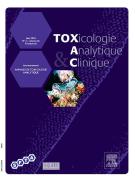A simple approach for determination of plasmatic levels of carbamazepine and phenobarbital in poisoning cases using DLLME and liquid chromatography - 20/11/23

 , Cleofas Sates b, Viviane Cristina Sebben c, Sarah Eller a, Marcelo Dutra Arbo b, Tiago Franco de Oliveira a
, Cleofas Sates b, Viviane Cristina Sebben c, Sarah Eller a, Marcelo Dutra Arbo b, Tiago Franco de Oliveira aSummary |
Carbamazepine (CBZ) and phenobarbital (PHB) are commonly used antiepileptic medications. Due to their accessibility and narrow therapeutic range, many cases of poisoning cases involving these substances have been reported, whether intentional or unintentional. In managing cases of CBZ and PHB poisoning, monitoring plasma levels are important to choose the best treatment for the patient and staging intoxication cases. The use of dispersive liquid-liquid microextraction (DLLME) has proven to be a good approach for toxicological analysis in biological samples and is increasingly used in the clinical-forensic scenario. This study aims to develop a simple method using DLLME and HPLC-UV for the quantification of CBZ and PHB in plasma samples from poisoning cases. The main variables involved in the DLLME were optimized using multivariate experiments. The procedure is based on plasma deproteinization using a dispersive solvent with subsequent extraction with the extractor solvent. The bioanalytical method was fully validated. The lower limits of quantification were 2μg/mL for CBZ and 10μg/mL for PHB and the calibration curve was linear (r2>0.99) for both analytes. The RSD% in within-run precision varied from 3.2% to 8.7% and between-run precision varied from 3.4% to 8.4%. Accuracy ranged from 85.4% to 105.0%. Normalized matrix factor (NMF%) ranged from 96.1% to 101.2% and the obtained recovery extraction was from 33.9% to 41.5%. The method was successfully applied to 42 plasma samples from suspected poisoning cases. All samples were positive for at least CBZ and/or PHB. The developed and validated method proved to be efficient, easy to execute, and implement, helping in the diagnosis of poisoning.
Le texte complet de cet article est disponible en PDF.Keywords : Carbamazepine, Phenobarbital, DLLME, HPLC-UV, Plasma samples
Plan
Vol 35 - N° 4
P. 293-305 - décembre 2023 Retour au numéroBienvenue sur EM-consulte, la référence des professionnels de santé.
L’accès au texte intégral de cet article nécessite un abonnement.
Déjà abonné à cette revue ?

